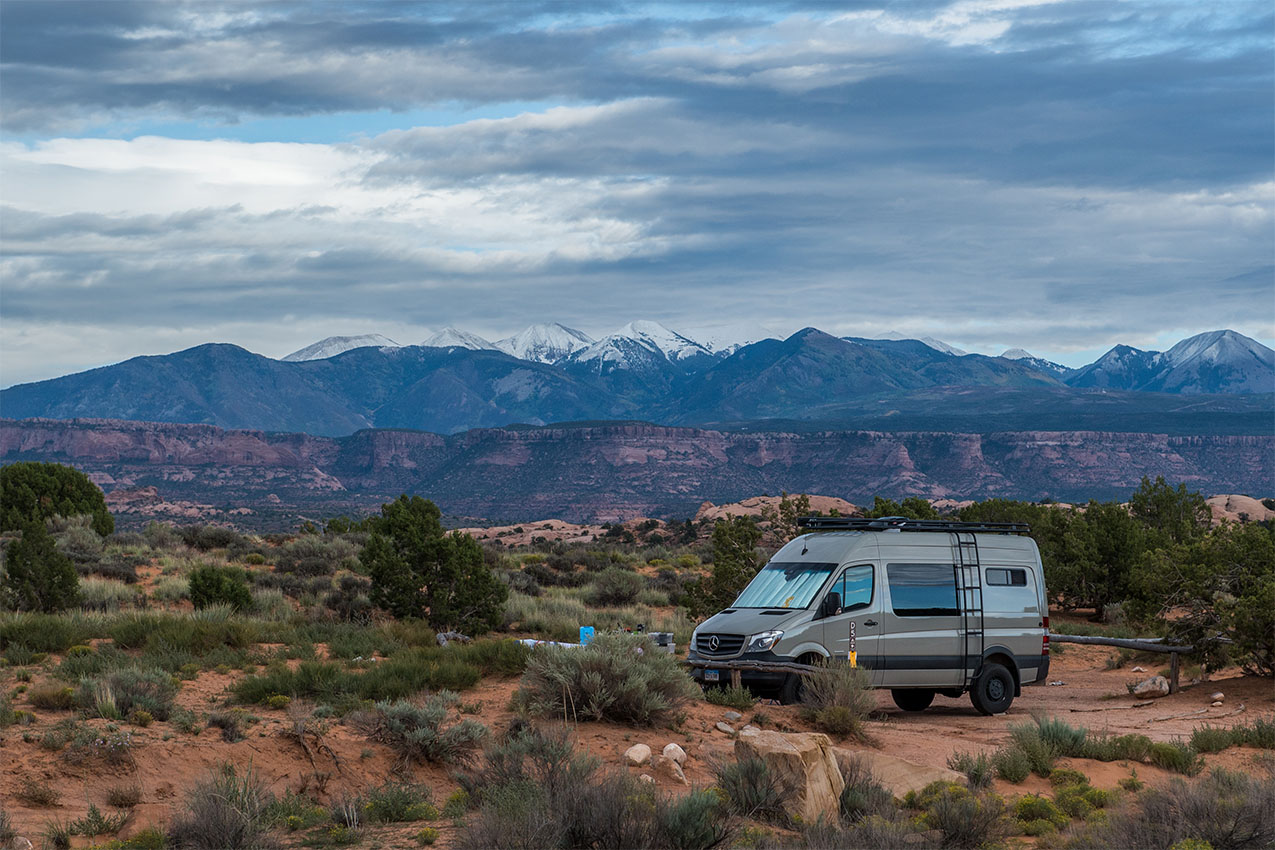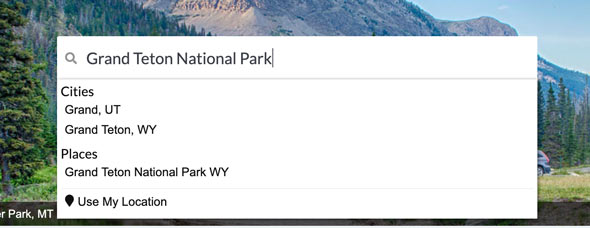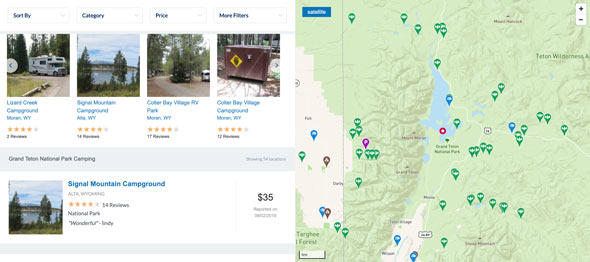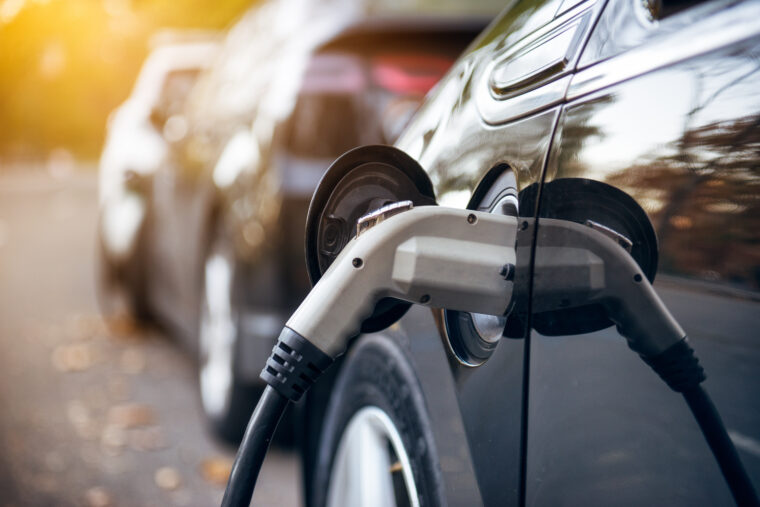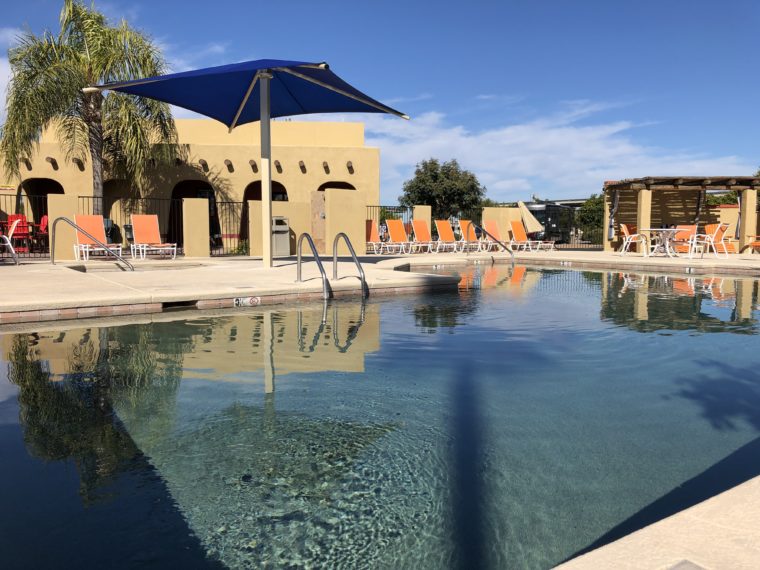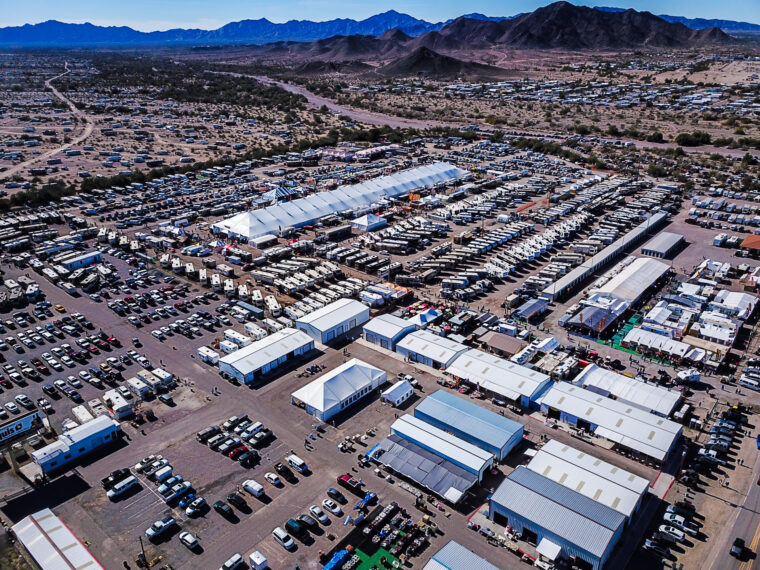While the downsides of traveling by van, as opposed to a larger RV, may seem immediately clear–less elbow room, often fewer appliances and typically a glaring absence of a dedicated place to use the bathroom–the smaller footprint means you’ll save cash on gas, leave less of an impact on Mother Nature and have an easier time navigating small towns and parking lots. The best part of camping in a van though is that you’ll be able to access places that large RVs and travel trailers simply can’t. Whether it’s a matter of turning radius, clearance or simply whether you’ll fit between and under those trees, a van allows you to bring some modicum of comfort along with you while still fitting into the places tent camping allows.
Depending on how tricked out your van is (i.e. whether you’re coated in solar panels, a pop-top, and/or wavy stickers that proclaim clearly that you’re an RV) you may even be able to “stealth camp,” which is a fancy word for parking on a city street, rest stop or friend’s driveway, and keeping your affairs in such an order as to avoid detection by the average passerby.
North America is full of places where van camping is not only possible, but legal, fun and convenient as well. Just as a van can make it easier to fit into that forest spot with the low hanging fir branches, so can it permit you entrance to large cities where RVs would struggle to make a right turn, let alone find a place to park for the night.
Let’s traverse these purple mountains majesty and amber waves of grain–and beyond–to find some of the best places to camp in a van.
Free Camping on BLM & National Forest Land
Now, there’s nothing preventing someone who’s chosen a Sprinter, VW Bus or an old Dodge campervan from cozying up to an RV park’s hookups and enjoying the activities that tend to prevail in that environment, but your typical vanlifer will be living as small as they do out of some desire to get further into nature a bit more easily.
To that end, the United States’ Bureau of Land Management property and national forests are the go-to spots to find yourself immersed in the goodness of the natural world. Short of penning the Great American Novel here today, it would be next to impossible to discuss them all, but luckily we’ve not only covered a plethora of national forests in various other articles here on Campendium, we also just so happen to be the best app on the Internet for finding such treasures. And did we mention that they’re often free?
We’ll review some of the best spots that are either better for vans than your typical RV, or just plain amazing regardless of your rig, but first let’s take a quick look at how to find endless spots here on the site.
How to Find Awesome National Forest and BLM Spots on Campendium
Let’s first assume you have a general destination in mind. If looking at a map of this continent simply befuddles you, though, perhaps zone in on a national park (Canada, the United States and Mexico all have them) and start from there. You can even search for the name of a national park right on Campendium. Let’s say we want to find some camping near Grand Teton National Park.
After doing so, you’ll see a selection of filters and a list of possibilities near the park you’ve searched for on the left, and a handy map on the right.
The filters are key here. If you’re looking to be in a natural setting, you probably want to skip the private RV parks and go with this Public filter.
Let’s say you really want to find yourself some solitude. Doing so increases your chances of dodging late night party people and the hum of a neighbor’s generator somewhat scientifically inverse to the likelihood you’ll be out of the range of cell phone service and city lights as well. This may not be your ideal setup, but for our purposes, we can set the Price to $0. The assumption here, which typically stands correct, is that few official campgrounds–even those in national forests and on BLM land–offer a spot for free, and only a rare handful of places with electric and water hookups do so. Thus, free equals remote, and there’s nowhere better to take your van than way out into the wilderness, at least in our current scenario.
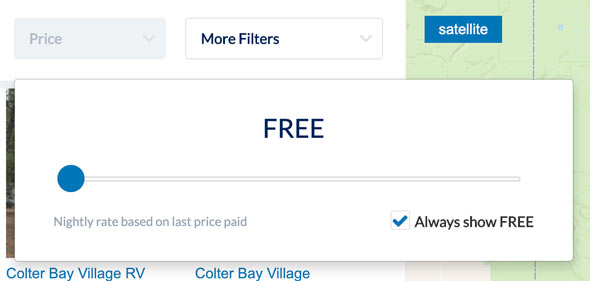
Now let’s say that, despite wanting to be miles from anywhere and anyone, you still need to work online or checking your Instagram is the only way your blood can process oxygen. Campendium has a filter for that, exclusively available to supporters. Look under the More Filters button.
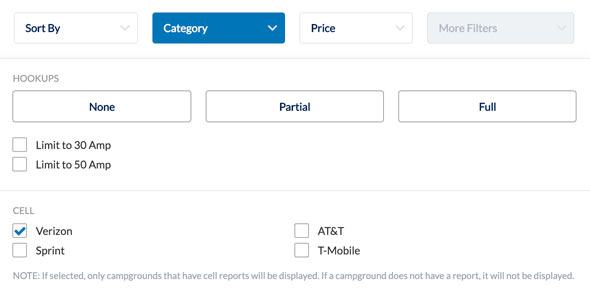
It’s only a few dollars a year (or month) to become a subscriber, and you can do so here. However, if you don’t have the cash or just aren’t ready to become a supporter, you could still click through and check cell reports on each campground.
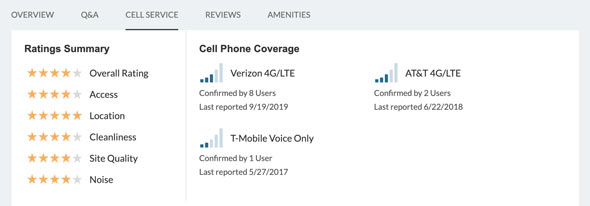
Voila! There it is, your perfect campground, or a list of spots to checkout, which can be half the fun of vanlife anyway.
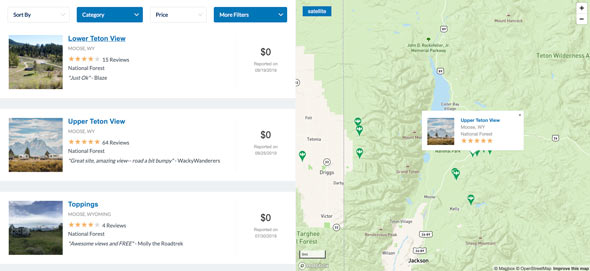
Some of the Best National Forests for Vanlife
If the rush of a river cutting through tree-bearded mountain ranges floats your van’s boat, the national forests are no doubt the best place to pop your top. Nearly all of them offer some combination of endless free places to camp and designated campgrounds, typically equipped with minimal amenities like a picnic table and fire ring at each site, plus vault toilets, for around $15 – $20 / night. Given the nature of forests, you can expect to escape the summer heat under the shade of towering pines and the occasional swimming hole alike. If you depend on solar, this may be one of the bigger drawbacks of having a canopied woodland above you, apart from chattering squirrels eager to steal your sandwich of course.
Before we dive into some of the best national forests for vanlife, though, let’s take a moment to recall our role in this natural world. National forests belong to all of us, it’s our tax money that goes to fund their upkeep and management, and as campers utilizing these wild resources, it’s our job to help preserve them. The forest service can’t be expected to pick up our trash, and our moms aren’t always available, so please never leave any of your own garbage behind, and–if you can–pick up a grocery bag or two’s worth of the last guy’s litter to do even more than your fair share. When scoring a free spot, don’t blaze a new trail–find a spot that’s already been clearly used and claim it for your own during the night or two you’ll be staying there. If gathering wood for a fire is allowed, don’t cut or break down trees (live wood doesn’t really burn anyway) but instead use dead and down wood. And while tidying up a previously built fire pit is fine, try and refrain from building new pits in general. You can read all about the Leave No Trace principles here, keeping in mind that if we all treat the forest like our personal junkyard, that’s what we’ll have available for future camping.
Vanlife Camping in National Forests of the Pacific Northwest
One of the best things about camping in a van is being able to fit into spots RVs can only dream of, whether it’s due to rough roads on the way in or limited space between the pinecones overhead. A great example of this can be found at Odessa Campground near Klamath Falls, Oregon. Reading through the reviews, you’ll see how those in a van trended toward a more complete constellation when rating this place than the folks who attempted to camp there in an RV or with a travel trailer. Sometimes, it’s simply a matter of how much easier it is to drive a van down a long dirt road than it would be to find your trailer full of broken dishes after doing so, such as at Head of the River in the Fremont-Winema National Forest, or the likelihood that you’ll still fit into that last spot on a Thursday afternoon in the thick of summer at campgrounds like French Pete in Willamette National Forest.
Vanlife Camping in National Forests of the American Southwest
Another benefit to camping in a van is the ease of packing your life in and out on a more frequent basis. RVs and travel trailers tend to have jacks, slides and a variety of other preparations needed before they’re fully “ready to camp,” whereas many a vanlifer can wake up, climb into the front seat and drive away, making exploring entire regions without committing to any particular spot a desert breeze.
One could, in a van, easily watch bison wander the North Rim of the Grand Canyon on Monday, get a free spot next to a lake and only a few miles from Grand Canyon Village by Tuesday and still make it into Flagstaff for sushi and frolf come Hump Day.
Some of the Best BLM Land for Vanlife
There’s nothing about the Burea of Land Management which says that it can only manage desert, but that’s the terrain you’ll encounter most often when exploring the property run by this particular government office. Whether that means the saguaro forest red rock expanses of Arizona or endless sagebrush basins in Washington’s high deserts though can mean the difference between sweltering sun or frigid night times where frost greets you come September’s mornings. The desert in North America can mean pristine clean white sands reminiscent of the Sahara, or Tatooine for that matter, as much as it can juniper forests surrounded by craggy mountains, cactus at your every footstep or the volcanic remnants of a long gone mountain turned endless black rock badland. Finding the perfect campsite might mean your van is the only sign of humanity between you and a purple scorched sunset or it could be tucked into a pile of boulders, hiding you from distant highway traffic.
Most BLM land is found out west, and here’s a sampling of some of the best that your van’s tires will ever tread lightly upon.
As with any public lands, please remember that it’s our responsibility to Leave No Trace when we’re out in the wild.
Vanlife Camping on BLM Land in the Great Basin
Sometimes the biggest benefit to vanlife is saving money on gas, and other times that perk becomes a necessity. US Route 50 in Nevada, known as the Loneliest Highway, is a great example, where you’ll see more pronghorn than gas pumps as you traverse this empty two-lane paradise. So fill up the tank and feel free to get lost at places like Hickison Petroglyph Recreation Area without fear of hitching it back to the next set of pumps.
Just because BLM land tends to encompass the desert, doesn’t necessarily mean it’s a free for all when it comes to access. Even the desert can be heavily treed with pinyons and junipers, or even thick sage, and the dirt roads stretching their spindly fingers into the most remote and beautiful parts of this nation can often be too choppy or washboard for RVs to traverse. Logandale Trails is a perfect example of exactly this. Of course, simply being able to traverse the roads and find a spot you’ll fit in aren’t the entirety of what makes a spot good for vanlife, Carlin Canyon is just off of I-80 in Nevada, with easy enough access for any rig, but still a beautiful place to get that perfect shot of your Vanagon as the sun sets over the mountains.
Vanlife Camping in the Rocky Mountains
Long stretches of uphill can put every horse in a Hemi to the test as bigger rigs struggle to find some downhill…only to realize that brakes last about as long as your first kiss, and those descents can easily be twice as exhilarating, but not always in the good way. Trade your Class A in for a Ford van though and suddenly you’re just another car on the road, ready for whatever I-70 or some dirt road switchbacks can through at you.
Get lost exploring Yellowstone Country, without the crowds, at places like Spirit Mountain Road. Disappear into the dense forests of Wolf Flats, west of Teton, without worrying about your turning radius or join the big boys for purple mountains’ majesty–complete with sunset crown–at Harper’s Corner Road.
Beach Camping in a Van
While beach camping isn’t typically an experience which is limited to those who travel by van, if you’re looking for that iconic “toes popping out of your sleeping bag with the back doors open” photo of the ocean, you’ll need to find yourself some beach camping.
Before you go headlights forward into the sand, though, make sure it’s firm enough to keep you from getting stuck, and note that the ocean’s tides can rise many dozen feet as the moon sways the tide from low to high. Waking up to saltwater pouring into the cracks between your doors as you’re slowly sucked out to Davey Jones’ vanlife locker is one of the lesser joys of beachgoing.
You’ll also want to bring a shovel, and maybe some maxtrax or leveling blocks, something to help give you some traction in case that firm sand you parked on last night decided to soften up overnight.
Beach Camping on the Oregon Coast
True beach camping, where your feet touch the sand the moment you roll out of your van every morning, is surprisingly hard to come by on the Oregon Coast. While places like Nehalem Bay State Park and Harris Beach State Park encompass the beach itself, their campgrounds are tucked into the Shore pine forest within walking distance of, but not properly on, the sand. Though they’re still some of the most natural settings you’ll find with convenient access to the waves, if you want to wake up to salty wind tickling your nose hairs, you’ll find most of those at private RV parks like Beachfront RV Park in Brookings, Oregon or settle with almost-beachfront access, where those stretches of the coast which still have their dunes intact–like at Horsfall Beach in the Oregon Dunes National Recreation Area–are the only barrier between you and the water.
Beach Camping on the California Coast
The Golden State is more generous with its beachfront camping than any other US state on the West Coast, though they’re not afraid to charge a premium for this access, either.
From camping within the beach dunes, ocean view and all, near the Redwoods to true beachfront camping just north of San Diego, there are spots available all along the coast. California manages state beaches–like Dockweiler, home to a similarly named RV Park near Los Angelese–and you’ll find no shortage of private affairs such as San Francisco RV Park happy to exchange their precious cliffside sunset views for your hard earned cash.
Many counties run their own RV parks on the ocean, such as Jalama Beach County Park northwest of Santa Barbara, and there’s even some BLM land offering the same for only a few dollars. The primary advantage with having a van in most of these situations comes down to site availability, as the shorter you are, the more likely you’ll fit into that last “tent” spot open for the rest of the summer.
Beach Camping in Maine
At the opposite end of the United States, a rugged coastline mimicking that found on the Oregon Coast waits those East Coast vanlifers. While finding a sandy beach in Maine isn’t impossible, most of the camping you’ll come across with immediate access to the Atlantic exists on the state’s infamous rocky cliffs that hug the shoreline.
Sunset Point, a private RV park outside of Harrington, is one of the campgrounds with easier access to the water. By comparison, Schoodic Woods–a campground atop a cliff in Acadia National Park–is more about ocean view overlooks.
Beach Camping on the Gulf of Mexico
Five states border the Gulf of Mexico, and while the notion of Florida resorts and Texan belt buckles may not conjure visions of easily accessible beach camping, it’s actually one of the easiest places to get a campsite directly on the beach. States along the gulf are teaming with everything from luxury RV resorts catering more to the 2019 Fifth Wheel crowd, state parks happy to house rigs as small as a hammock hikers, and restaurants open to the concept of you leaving your van’s top popped after you spend the evening emptying their Jaegermeister stores.
In the Florida Keys, one of the most pristine ocean views you’ll find in these United States awaits those ready to make a reservation well in advance at Bahia Honda State Park, but again, your van will give you a 376% better chance at scoring some last-minute cancellation than you would have were you to roll in with the F350, forty-foot trailer and boat in tow combination many a Keys RVer will show up with. Back on the mainland, Florida’s Gulf Coast is replete with palm tree-forested, sand between your toes hidden gems such as Oscar Scherer State Park, which won’t put you precisely on the water but won’t leaving you wondering how to make your way to it either. St. George Island State Park provides a similar experience on the Florida panhandle, not exactly beachfront but no less worthy of the sea salt spray and sunset glory one comes to the ocean to experience.
As you stroll into Alabama, your small size will save you some screen time searching for a campground as well, where oceanfront Meaher State Park is often full as far as RV access goes, that van you call home means you can pop over to the tent section which almost never fills up. Many places in this Deep South stretch of the Gulf of Mexico just feel more appropriate for a van, too, like Point Cadet Park in Mississippi, a city affair that amounts to little more than a parking lot steps from the beach where a van could easily tuck and blend in with the rest of the cars looking to pitch an umbrella for the day. Louisiana’s Department of Fish and Wildlife does beach camping like most of us imagine it’s going to be, where Rutherford Beach allows for tires on the tide (well, probably best not to take that literally) parking absolutely free.
Perhaps nowhere in this country will you find as much oceanfront camping, some exclusively accessible by smaller rides, than the Lone Star State. Sea Rim State Park tends to fill up quicker than a van family’s back seat, but for $10 per night you can camp directly on the beach and you bet your van will fit on that stretch of sand. A slew of similar affairs, including Crystal Beach, a county park on the Bolivar Peninsula and Padre Island National Seashore’s South Beach. From there, you’ll be ripe to take advantage of camping in Texas’ many amazing state parks and Big Bend region, where your van will help you get way off-grid in a way RVs can’t always.
Vanlife in Baja California
Should you get the urge to explore Mexico, there’s no better place to get your feet wet in our Spanish-speaking neighbor to the south than Baja. While most of the locals may not speak English, they’re typically welcoming and friendly to those of us who don’t remember much of our high school español and you can drive all the way to Cabo without needing a vehicle permit (though should you decide to cross the Sea of Cortez and travel into the mainland, you’ll need to purchase said vehicle permit way back at the border – you can’t get it anywhere else.)
Traveling in Mexico, in general, is best done via van. Many of Baja’s small towns have streets built for burros and never quite improved for modern vehicles, so lanes are narrow and turns can be tight, exactly the type of terrain where a van excels. Camping in Baja can range from broken down old RV parks right on the gulf to wide-open beaches overlooking the Pacific, forested sites near waterfalls to a free overnight in a restaurant parking lot (after you’ve paid for a meal, of course.)
A vanlifer could easily spend months in Baja and camp absolutely free every night. Everything in Mexico is cheaper than in the US and Canada, as well, and as you get closer to La Paz you’ll find most of the modern big box stores and chains–think Walmart, McDonalds and Autozone, or their Mexican equivalents–that you may be used to in your home country.
A few more interesting and unique places to camp in Baja which are ideal for van camping include an orange grove near the untainted-by-tourists Mulege, a remote beach down a steep mountain cliff south of Loreto and a private residence in the heart of Cabo San Lucas.
Stealth Camping in a Van
Finally, there is stealth camping. While it doesn’t specifically mean you’ll be sleeping somewhere that camping is frowned upon, or downright illegal, the concept generally entails sleeping in your van in a way that prevents others from even realizing there’s someone snoozing there on the side of the street. It’s another benefit of having a van, as opposed to an RV, as your home on the road, and is also one of the best ways to explore towns and cities which lack RV parks, or allow you to fully appreciate a brewery’s full line of craft beers while still walking home. While you won’t find stealth camping “spots” on Campendium (kind of defeats the point if we all start advertising this stuff,) there are some general ways to find a legit spot to camp in a city.
Checking with the town’s chamber of commerce or police station will tell you instantly how the general community looks at folks living out of vans on their streets. Getting friendly with the bartender or manager at a local establishment, and tipping accordingly, may earn you the okay to crash in the parking lot for the night. Most Walmarts, many Cabela’s and Cracker Barrels will allow you to stay the night in their lot as well, and some of these are actually listed here on Campendium, just use the parking lot search filter. Stealth camping is also a great way to park in a friend’s driveway, but not let every passerby know you’re doing so.
Vanlife may not be for everyone, but it’s also for anyone who wants to give it a try as well. A van can be more affordable than an RV, and even with its limited size, plenty of families live out of them while they travel. If you’re on the fence or just daydreaming of making your own vanlife happen, hopefully now you have a few ideas of some of the best places to go when you hit the road!
